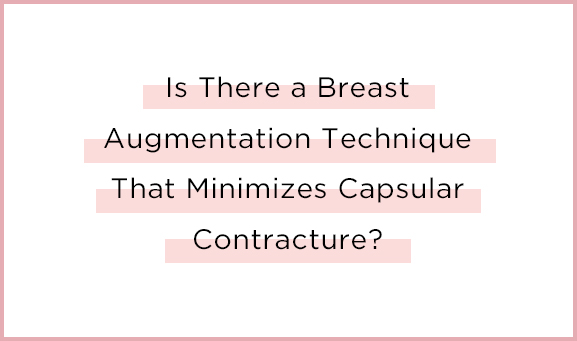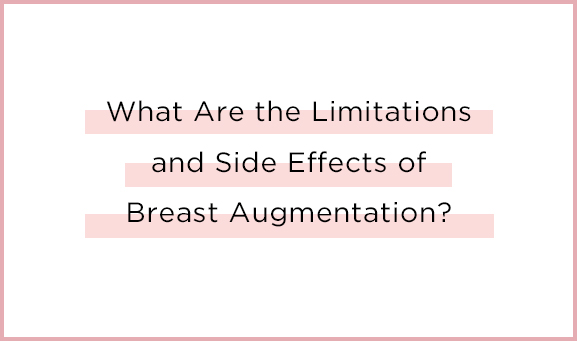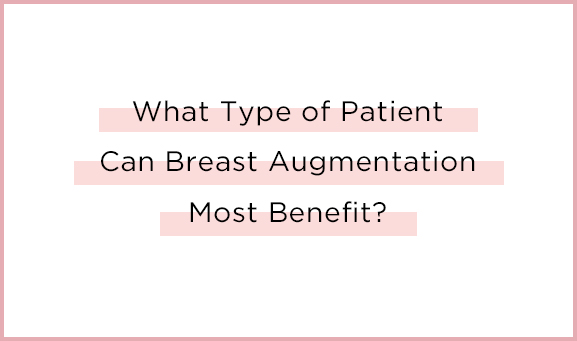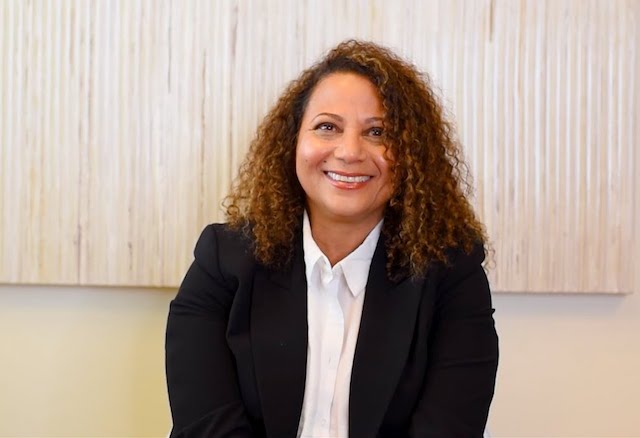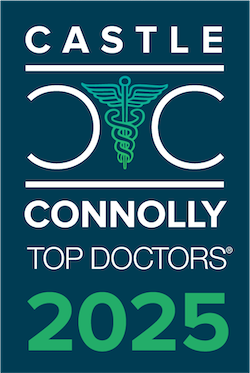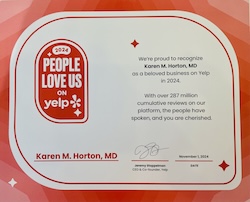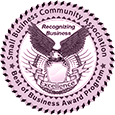Dr. Karen Horton has either authored or reviewed and approved this content.
Breast Augmentation
What is Breast Augmentation?
Breast augmentation is a Plastic Surgery procedure designed to enhance the size, shape, and overall appearance of the breasts using breast implants. This procedure is popular among women seeking to improve breast volume loss due to weight loss, pregnancy, or aging, as well as those desiring a more proportionate breast size or correction of asymmetry or a tubular breast shape.
Internationally Board-Certified Plastic Surgeon Dr. Karen Horton uses advanced techniques and a variety of implant options, including silicone gel, cohesive gummy bear implants or permanent adjustable saline-filled devices in reconstructive situations, to achieve each patient’s unique aesthetic goals. Breast augmentation can improve or enhance the breast shape, improve patients’ self-confidence, and provide beautiful, natural-looking results when performed by an experienced Board-Certified Plastic Surgeon like Dr. Horton.
Did you know Dr. Horton had a breast augmentation herself?
And she blogged about it?
Curious about breast augmentation?
Download our free Breast Augmentation Guide!
Download our free Breast Augmentation Guide!

Benefits of Breast Augmentation Surgery
Breast augmentation offers numerous potential benefits for women seeking to enhance their appearance and boost their self-confidence related to their breasts. Each patient has unique reasons for pursuing breast enhancement, and breast implants can help achieve a variety of aesthetic goals, including:
- Restoring breast volume lost due to pregnancy, breastfeeding, weight loss, or aging
- Enhancing breast size, shape, and projection for a more balanced figure
- Correcting breast asymmetry for improved symmetry and proportion
- Increasing self-esteem and confidence in swimwear, lingerie, and form-fitting clothing – without the need to wear a bra
- Creating a more youthful breast appearance with enhanced cleavage and contour
In addition to aesthetic augmentation, breast implants can also be used in breast reconstruction following mastectomy. Board-Certified Plastic Surgeon Dr. Karen Horton customizes each breast augmentation procedure to the patient’s anatomy and aesthetic goals, ensuring natural-looking results and a positive, empowering experience.
Inside the Procedure
Common questions about breast augmentation answered by Dr. Horton
Meet Dr. Karen M. Horton
How can Breast Augmentation cause Capsular Contracture?
How is Breast Augmentation performed?
How long does Breast Augmentation last?
Is Breast feeding after Breast Augmentation possible?
Breast Augmentation technique minimizing Capsular Contracture?
Is there an age limit for Breast Augmentation patients?
Is there an ideal candidate for Breast Augmentation?
What are the limitations and side effects of Breast Augmentation?
What is the average cost of Breast Augmentation?
What is the recovery time for Breast Augmentation?
What type of patient can Breast Augmentation most benefit?
Who is a Good Candidate for Breast Augmentation?
Candidates for breast augmentation typically include individuals in good physical health with realistic expectations who wish to enhance their breast size, shape, or symmetry. Ideal candidates may have naturally small breasts, volume loss from pregnancy, breastfeeding, weight loss, or aging, or desire correction of asymmetry.1 Board-Certified Plastic Surgeon Dr. Karen Horton works closely with each patient to determine if breast augmentation is the right choice based on their anatomy, goals, and lifestyle.
Read more about breast augmentation with Dr. Horton in her blog
Featured Case
Drag the slider to see transformation
Drag the slider to see transformation
What Types of Breast Implants Are Available?
Dr. Karen Horton offers a wide range of breast implant options to suit different body types and aesthetic goals. All breast implants have a shell made of silicone – which is an inert, non-reactive material. For most patients, Dr. Horton recommends soft and natural-feeling silicone gel breast implants for their beautiful outcome, their durability, and high aesthetic appeal.
She prefers high-quality implants from Sientra or Natrelle, both known for their safety, longevity, and natural-looking and -feeling results. Our office stays up to date with advancements in new technology such as new implants on the market – technology is always changing, and new options are available to patients every few years.
We recommend smooth-surfaced implants for our patients. Textured breast implants are associated with more rippling (visible wrinkles of the implants through the skin) and are reported to be associated with development of a rare subtype of blood cell cancer (bia-ALCL). Learn more here.
Saline Implants
Filled with sterile saltwater, saline breast implants and are FDA-approved for patients 18 years of age and older. They are inserted empty and filled with saline solution during surgery, sometimes allowing for smaller incisions. Dr. Horton uses a permanent, postoperatively adjustable saline implant for breast reconstruction after a mastectomy for breast cancer or in other conditions causing breast asymmetry such as Poland Syndrome or congenital breast hypoplasia. The major advantage of saline-filled implants is that they are adjustable – this is why they are used for reconstructive purposes. Following healing after breast reconstruction, saline implants are often exchanged for silicone devices for the very best aesthetic outcome.
Standard Silicone Implants (“soft gummy bears”)
Silicone gel breast implants are filled with soft, cohesive silicone gel that mimics natural breast tissue and has less rippling/wrinkling than saline implants, ideal for patients wanting a realistic look and feel. Dr. Horton offers all brands of silicone gel breast implants, trusted for their quality and aesthetic results. Silicone implants are FDA-approved for patients 22 years and older.
Highly Cohesive Silicone Gel Implants (“firm gummy bears”)
More highly cohesive gel implants are available that tend to retain their shape even if the shell is compromised, minimizing rippling and providing durable results. Dubbed the original “gummy bear” implants, these implants usually feel stiffer than other types of silicone gel. They also carry a small risk of “flipping” upside down in their pocket, which may necessitate surgery to flip them back and close off the implant pocket. They are used mostly for breast reconstruction when rippling of the implant through the skin is an issue.
Dr. Horton helps each patient select the best implant type, shape, and size to achieve their desired breast augmentation results, ensuring a tailored approach to every procedure.
Learn More About Silicone Gel Implants
Dr. Karen Horton Talks about Silicone Breast Implants
Natrelle Cohesive Gel Implants
Breast Augmentation Incision Options
Dr. Karen Horton offers several incision options for breast augmentation, each with its own benefits and considerations:

Inframammary Fold (IMF) Incision
Placed in the natural fold beneath the breast, this is the most common incision due to its ability to preserve breastfeeding function, nipple sensation, and future mammogram readings. It has the lowest complication risk, and allows for precise implant placement and is necessary for future breast surgeries.
Peri-areolar Incision
Made along the lower edge of the areola, this option is less common due to potential risks such as loss of nipple sensation, breastfeeding challenges, and visible scarring. There is an increased risk of capsular contracture associated with incisions around or through the areola as bacteria live in and around the nipple – therefore, this incision is rarely recommended.
Trans-axillary Incision
Made in the armpit, this scar is hidden with the arms down (visible when the arms are raised), it usually requires the implant to be placed under the muscle, it affords poor visibility of the implant pocket and cannot be reused for future procedures and carries a slightly higher risk of infection. For these reasons, the trans-axillary incision is also rarely suggested.
Trans-umbilical (TUBA) Incision
Made in the belly button, this method is rarely used due to its complexity, limited implant options, and potential for visible scar tissue. Only saline-filled implants are able to be inserted in a rolled-up fashion through a tube that travels under the skin to a pocket under the breast. Visualization is poor, it is a single-use incision, and permanent scar bands under the skin are other complications.
Dr. Horton discusses each breast augmentation incision option during implant-related consultations to ensure patients make informed decisions based on their anatomy, lifestyle, and goals.
After thinking about doing this surgery for many many years, I finally decided to do it and after doing my homework chose Dr. Karen Horton!
A. McDonald, San FranciscoDr. Horton and her staff were fantastic! I had my bilateral mastectomy reconstruction redone after 10 years as I was embarrassed at how I looked and she gave me my breasts back, tattoos during surgery and all! I gave her 5 stars out of 5, she really earned 10 stars out of 5. Amazing compassion, professionalism, artistry and medical expertise! The pre-surgery education and post surgery education kept you informed making the process easier. Thank you Dr. Horton for helping me and caring for me. The 4 hour drive to SF for appointments was so worth it!
Dr. Horton is wonderful! Thank you so much for taking the time to go above and beyond - every visit to the office is a positive experience thanks to Dr. Horton and her wonderful Team. They really make an extra effort to listen - and are all friendly, thoughtful and committed to getting fantastic results! Cheers and thanks again!!
Breast Implant Placement Options
Subglandular Breast Implant Placement
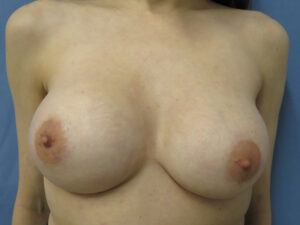
Implants are placed above the pectoralis major muscle on the chest wall but beneath the breast tissue. This option is preferred by Dr. Horton for nearly every patient (including herself – read her blog!) for the subglandular more natural look, consistent breast shape over time, and preservation of muscle function. It reduces post-surgery discomfort and avoids muscle-related deformities, making it ideal for active, slender, athletic patients or those seeking natural breast movement.
Submuscular Breast Implant Placement
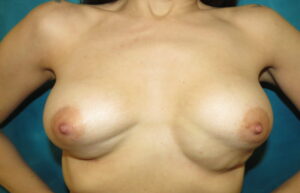
Submuscular Implant (Before Surgery)
Implants are placed beneath the chest muscle, which can provide additional coverage for patients with minimal breast tissue. However, it usually creates an animation deformity with muscle flexion, significantly more post-operative pain and swelling, and potential muscle strength changes. This placement may also lead to the ‘Snoopy deformity’ or ‘waterfall deformity’ over time, where the muscle pulls the implant up high and the breast tissue sags or falls off the implant, creating the false appearance of breast droop.
Dr. Horton carefully evaluates each patient’s anatomy, lifestyle, and preferences to recommend the most suitable placement for natural, aesthetically pleasing results. She usually recommends for her patients what she would want for her own body.
Choosing Your Breast Implant Size
Selecting the right breast implant size is a personalized process tailored to each patient’s body, lifestyle, and aesthetic goals. Dr. Karen Horton emphasizes that breast augmentation is more than just picking a size; it involves thorough planning, open communication, and a keen aesthetic eye.
Patients are encouraged to bring in ‘Wish Pictures’ — including ‘YES’ images that reflect the breast size, shape, and projection they desire — as well as ‘NO’ breast images that highlight what patients want to avoid. These visuals help Dr. Horton understand each patient’s vision and ensure realistic expectations. During consultations, Dr. Horton considers factors like height, weight, body proportions, and lifestyle to recommend an implant size, shape and projection that enhances the patient’s natural figure while maintaining balance and harmony.
This collaborative approach ensures that every patient feels confident in their choice, resulting in breast augmentation outcomes that are both beautiful and natural-looking.
How Do I Select the Right Breast Implants?
Read more about choosing the right breast implants in Dr. Horton’s blog!
Read More
Anne's Patient Story
Natalie's Patient Story
Preparing for Breast Augmentation
The first step in your breast augmentation journey is your personal consultation with Dr. Horton. At your initial breast augmentation consultation, a complete medical history will be taken. Dr. Horton will spend a great deal of time with you getting to know you personally. She will explore your reasons for seeking surgery and examine your breasts. If you are an appropriate candidate for breast augmentation, your options will be described in detail.
Proper preparation is essential for a smooth breast augmentation experience and optimal results. Dr. Karen Horton provides each patient with detailed written preoperative instructions, including guidance on medications to avoid, lifestyle adjustments, and planning for recovery. Patients are advised to stop smoking, arrange for post-surgery transportation, and ensure they have support during their initial recovery period – including another adult at home with them at least the first night after surgery. Dr. Horton also emphasizes the importance of discussing all questions and concerns during pre-surgery appointments to ensure patients feel confident and well-prepared.
Note: GLP-1 medications must be stopped a full month before any surgery under general anesthesia to avoid complications. Learn more about how to stay safe when taking diabetic or weight loss medications including semaglutides in this blog post.
The Breast Augmentation Procedure
The breast augmentation surgical procedure with Dr. Karen Horton is performed under general anesthesia to ensure patient comfort, safety and a reliable outcome. The procedure begins with carefully making the selected incision type, followed by the creation of a pocket to accommodate the breast implant. Dr. Horton then places the implant either above or below the pectoral muscle, based on the pre-surgical plan tailored to the patient’s anatomy and aesthetic goals.
Drains are inserted, an antibiotic solution is used to irrigate the pocket and the implant, and the no-touch technique is used to insert each implant. Incisions are meticulously closed in layers of dissolving sutures to minimize scarring, and surgical dressings are applied. Dr. Horton’s precise techniques and attention to detail help ensure natural-looking results and a smooth recovery process. Patients are provided with comprehensive post-operative care instructions to support healing and achieve the best outcomes.
Dr. Horton places surgical drains to provide an outlet for wound fluid that is produced in the pocket created for the breast implant, which helps to decrease the risk of complications such as capsular contracture and hastens postoperative recovery. We urge you to read Dr. Horton’s blog post on surgical drains and watch all of the accompanying videos so that you are well prepared to care for your drains after surgery. Drains are removed within the first week, and do not hurt. “Drains are your friends”!
Did you know Dr. Horton had a breast augmentation herself?
And she blogged about it?
Recovery After Breast Augmentation
Recovery from breast augmentation typically involves some tenderness, swelling, and bruising, which can be managed with prescribed pain medication or regular Tylenol (Acetaminophen). Patients are advised to rest and avoid strenuous activities for the first 1-2 weeks, including lifting anything over five pounds. Light activities can gradually resume, but strenuous exercise should be avoided for one month. While visible enhancement is noticeable immediately after surgery, final results may take several months to a year as swelling fully subsides. Dr. Horton provides personalized recovery instructions and ongoing support to help ensure a smooth healing process and optimal results.
Your own preoperative and postoperative photos will be reviewed with you during follow-up visits and can be shared with you securely through the Symplast patient App.
Dr. Horton had breast augmentation herself, and she blogged about it! Learn more about her experience!
Implant Massage
During the first month of your recovery, you will be instructed by Dr. Horton and our aesthetic surgery staff on how to perform breast implant massage. Don’t worry, it does not hurt! It is important that you gently move your implant around in its pocket to avoid scar tissue from contracting around the implant (known as capsular contracture). Implant massage also can serve as a breast self-examination.
Procedure FAQs
Is breastfeeding possible after breast augmentation?
Breastfeeding is typically still possible after breast augmentation as long as the breast tissue and milk ducts remain intact during surgery. Dr. Horton prioritizes techniques that preserve essential structures, such as using the inframammary incision, to reduce the risk of interfering with breastfeeding abilities.
Will breast augmentation affect nipple sensation?
Nipple sensation may be temporarily affected after breast augmentation, but it usually recovers over time. Patients should allow several weeks to months, up to a full year or longer for full sensation to return. Dr. Horton uses careful surgical methods to minimize the risk of long-term changes in nipple sensitivity.
Can breast implants help achieve more youthful breasts?
While breast implants enhance breast size, they may not address sagging or other age-related changes in breast appearance. For patients seeking a more youthful look, Dr. Karen Horton often recommends combining breast augmentation with a breast lift. This procedure raises the nipples and areolas to a higher position and removes excess lower pole breast skin and/or tissue, creating a rejuvenated and more youthful breast contour.
What will my scars be like after breast augmentation?
The inframammary scar used for breast augmentation is a fine, thin line approximately an inch to an inch and a half long. If a breast lift is also performed at the time of augmentation, additional “lollipop” incisions will also be concealed in a bra or bikini top. Dr. Horton recommends medical-grade scar gel, available in her online store, and patients may see a member of the San Francisco Plastic Surgery team for scar therapy after surgery.
Can I have mammograms with breast implants?
Regardless of the location of implant placement (under the muscle or not), the fill material (silicone or saline) and the implant size, having a breast augmentation does not interfere with breast self-examination, physician breast exams, mammograms, ultrasound, MRI or any other cancer detection techniques. Dr. Horton shares her mammogram experience after breast augmentation in her blog - read it here!Breast augmentation will not change your personal risk of breast cancer, nor will implants interfere with cancer screening. If you are over the age of 40 years, you should have a baseline preoperative mammogram before breast augmentation (or any surgery of the breast).If you are under 40 years, routine mammography screening is not recommended as long as there is no history of breast or ovarian cancer in your immediate family. Dr. Horton will take a complete history at your consultation and will make recommendations for breast imaging or other referrals, if necessary.When you have implants in place, please notify the mammogram technician and they will perform additional images (known as Eklund displacement view” - or the “horizon view”) to ensure that all breast tissue is fully visualized around the implant.
Mammograms with Breast Implants: Q & A with Dr. Horton
Learn more about mammograms after breast augmentation in this blog by Dr. Karen Horton.
Read More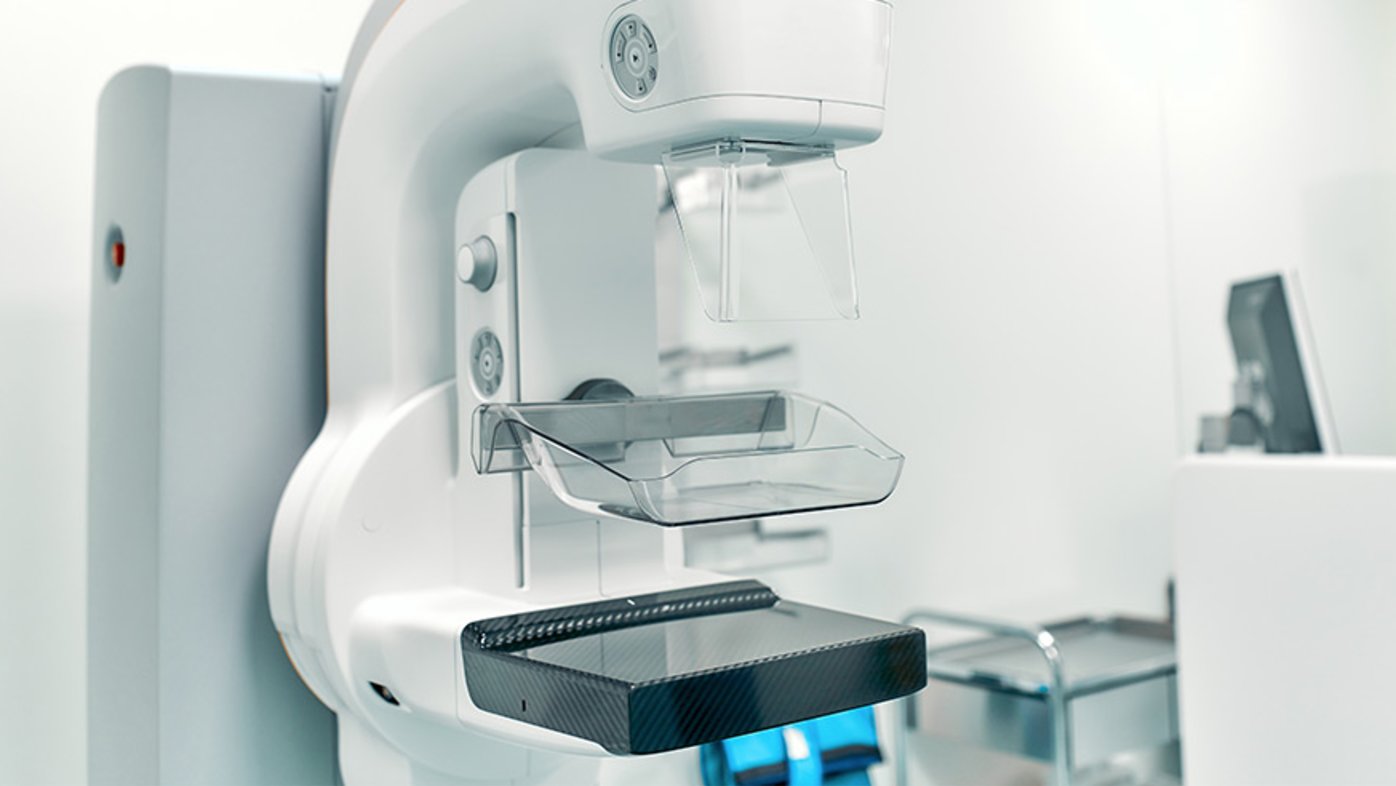
Procedure FAQs
Do breast implants cause cancer?
Breast implants have been linked to a very rare type of cancer known as anaplastic large cell lymphoma (ALCL), particularly in patients with textured implants. The risk is extremely low, with estimates ranging between 1 in 2,207 and 1 in 86,029 women with breast implants2. ALCL is typically treated by removing the implant and surrounding capsule.Breast implants have not been shown to increase the risk of breast cancer.3 Studies indicate that women with breast implants are not at higher risk for breast cancer, nor do implants interfere with the accuracy of mammograms or ultrasounds in detecting breast abnormalities.
What are the risks associated with breast augmentation?
All breast implants used by Dr. Karen Horton are FDA-approved and have been demonstrated to be safe through scientific research. However, like any surgical procedure, breast augmentation carries some risks. One of the most common long-term risks is capsular contracture, where scar tissue around the implant tightens, potentially causing discomfort or affecting breast appearance. Dr. Horton’s surgical expertise helps reduce this risk, and she is extensively experienced in performing breast implant revision procedures if needed.
How can breast augmentation cause capsular contracture?
Additional risks associated with breast implants include:
- Breast Implant Illness (BII) – also termed “Systemic Symptoms related to Breast Implants” (SSBI) in the medical literature – read Dr. Horton’s blog series about this condition
- Pain or discomfort
- Breast implant rupture/implant breakdown (saline and silicone)
- Deflation of saline implants
- Silent rupture of silicone implants
- Asymmetry
- Infection4
- Change in breast sensation
- Scars
- Breast implant associated anaplastic large cell lymphoma (bia-ALCL) – textured implants only (not offered in our practice) – learn more here
Dr. Horton’s expertise as a Board-Certified Plastic Surgeon with over two decades of breast reconstruction experience helps reduce these risks, ensuring patients receive the highest quality care throughout their breast augmentation journey.
Procedure FAQs
Will I need additional surgery after breast augmentation?
While breast implants are designed to be long-lasting, some patients may require additional surgery in the future, such as implant removal, replacement, implant pocket adjustment or scar revisions, based on their changing needs or preferences. Dr. Karen Horton emphasizes that there is no set timeline for implant revision, and additional surgery is only necessary if complications arise or if patients wish to make changes. Regular follow-up visits with Dr. Horton helps ensure long-term satisfaction and address any concerns over time.
How much does breast augmentation cost in San Francisco?
The cost of breast augmentation varies depending on factors such as the type of implants, surgical technique, and individual patient needs. Dr. Karen Horton provides detailed cost estimates during consultations, ensuring patients understand all aspects of their breast augmentation procedure without listing specific prices online. Want to learn more about Breast Augmentation? Check out Dr. Horton’s blog!
Where Can I See Before and After Photographs of Breast Augmentation?
Please visit our patient gallery to see before and after breast augmentation pictures!
Schedule Your Breast Augmentation Consultation
If you are considering breast augmentation, Board-Certified Plastic Surgeon Dr. Karen Horton offers personalized care, decades of experience and exceptional aesthetic results. Schedule a consultation with our San Francisco breast augmentation surgeon to discuss your goals, explore your options, and begin your journey to enhanced confidence and beauty. Contact our San Francisco Plastic Surgery Bay Area office today to take the first step toward achieving your aesthetic goals.
Schedule An Appointment
Sources
1 American Society of Plastic Surgeons. Who is a good candidate for breast augmentation? Available: https://www.plasticsurgery.org/cosmetic-procedures/breast-augmentation/candidates. Accessed February 13, 2025.
2 FDA. Questions and Answers about Breast Implant-Associated Anaplastic Large Cell Lymphoma (BIA-ALCL). Available: https://www.fda.gov/medical-devices/breast-implants/questions-and-answers-about-breast-implant-associated-anaplastic-large-cell-lymphoma-bia-alcl. Accessed February 13, 2025.
3 Hoshaw SJ, Klein PJ, Clark BD, Cook RR, Perkins LL. Breast implants and cancer: causation, delayed detection, and survival. Plast Reconstr Surg. 107(6):1393-407, 2001. Accessed February 13, 2025.
4 FDA. What to Know About Breast Implants. Available: https://www.fda.gov/consumers/consumer-updates/what-know-about-breast-implants. Accessed February 13, 2025.






